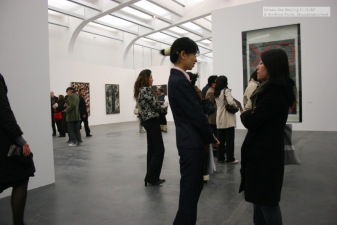(Well, after a long hiatus, I'm back to posting. October was mainly taken up with the Dartmouth FSP fieldtrip, which took us to Shanghai, Suzhou, Zhujiajiao, Hangzhou, Moganshan, Shaoxing, Ningbo, and Putuoshan. No need to elaborate--unless you enjoy accounts of medium long bus rides, 4-star hotels, and tourist sites. Do have to say that Putuoshan, which I hadn't been to before, was well worth the visit. Back in Beijing for a week now. Getting ready to put my doco on Chinese indie rock into a higher gear. Already arranged interviews with several people for next week. Also need to plan our next fieldtrip to Luoyang and Xi'an!)

Last night I attended the opening party for the new Ullens Center in the 798 Arts District in Beijing. The Ullens Center takes up a large factory space across from the bookstore/cafe Timezone 8. It has been nicely renovated and painted in white. The center functions as a museum and knowledge center for Chinese arts, showcasing the Ullens collection. A friend of mine in the art world who invited me to the event told me that the Ullens couple has struggled hard to get this center going. Baron Guy Ullens is apparently from Belgian royalty with a long lineage of collectorship and he and his wife Myriam have been putting a lot of their considerable financial weight behind the building of a substantial Chinese art collection. The Ullens Center is meant to serve the people of China, and others around the world, as an educational center for contemporary Chinese art. It may not be the Pompidou, but it's a big step in the right direction.
The exhibit on display, painstakingly collected by the curator Fei Dawei, now showcases Chinese art of the mid-1980s. In the '80s, Chinese art was just beginning to break out of the shackles of Maoist political propaganda and a slew of brave young artists were forging major new directions for their successors to follow. Here's a description of the event that I took from the website www.ullens-center.org:
’85 NEW WAVE - THE BIRTH OF CHINESE CONTEMPORARY ART
BRIEF INTRODUCTION
’85 New Wave is an exhibition that takes a step back from this commercial fray to examine a unique episode of art history when China began reinventing its own culture. The 1980s in China represented a kind of explosive answer to the Cultural Revolution of the 1960s and 70s, when China was not only cut off from the rest of the world, but was also forced to disown and renounce its own culture. Suppression of such a powerful culture could only be met with an equal and opposite force. The result of this explosive reaction was the '85 New Wave Movement. This search for new artistic language and dialogue sent art ists in pursuit of multiple lines of enquiry. After decades of political movements, the line of modern Chinese artistic development had been seriously eroded, leaving only traces from which to reinvent a new culture. Forced to work almost from scratch, artists instigated a parallel and alternative contemporary art history to the West that brought Chinese art from strict socialist realism to mature experimental and conceptual practice in just a few years. Consequently, this will be the first time that a comprehensive exhibition of this period will be presented to the public since the 1980s.
CURATORIAL STATEMENT
Between 1985 and 1990, a group of over one thousand young Chinese artists living in an environment without galleries, museums, or any systematic support for art and with unprecedented enthusiasm and passion, led a fundamentally influential artistic movement. It marked the end of a monolithic artistic model, achieving unprecedented freedom and opened a path for Chinese art to march toward internationalization and contemporaneity. After 1985, “contemporary art” irreversibly became the driving force behind Chinese art. This is the famous “’85 New Wave Movement”.
The “’85 New Wave Movement” represents a watershed in contemporary Chinese art history, which departed from the old time and pointed out a new direction. This movement also cultivated a group of artists that have impact in the world, with their works influenced and changed the direction and structure of Chinese and world art.
And yet today, our understanding of this incredibly important period remains remarkably limited. Aside from a small number of printed materials, we are rarely able to see original works from the “’85 Period.” A great number of works were lost or dispersed abroad. This is the first retrospective exhibition of the “’85 Movement” twenty years after it has run its course, but luckily we have found many important works from this period. In this process, we have been fortunate to have the enthusiastic support and encouragement of many artists and collectors, allowing us to re-present a basic outline of this precious period to the public. This exhibition also marks the publication of many previously unpublished documentary materials and manuscripts, allowing the viewer to bear witness to the deeply layered intellectual activity of the period.
By Fei Dawei
I strongly encourage everyone living in or visiting Beijing to go see this new center and visit the '85 New Wave exhibit. I have uploaded some photos from the exhibit to whet your appetite.